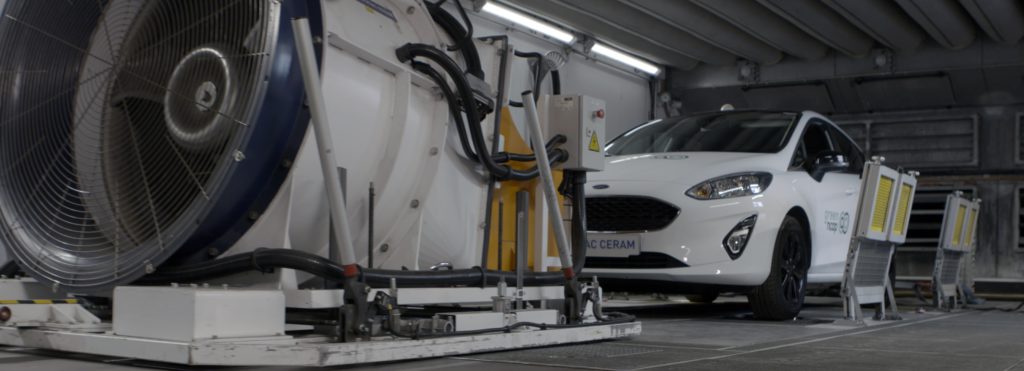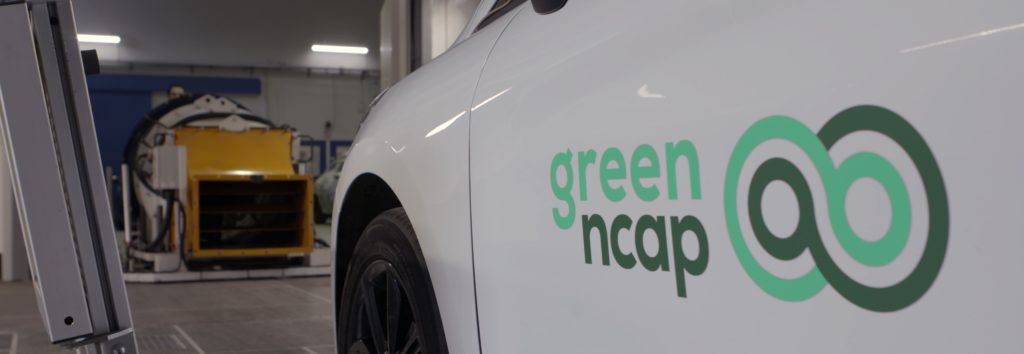
In laboratory tests, a car is put on a chassis dynamometer – a ‘rolling road’ – and is driven through a prescribed test cycle. During the test, exhaust gases are collected. These gases are analysed at the end of the drive-cycle to determine the amount of pollutant emissions, particulate matter and greenhouse gases the car emitted during the cycle.
The dynamometer can be set to simulate the resistance a car would normally experience in real-world driving. These are mainly an inertial resistance (i.e. a heavier car is more difficult to accelerate than a light one) and aerodynamic drag. So, a light, streamlined car is tested on the dynamometer with less resistance than a heavy one with poor aerodynamics.
At the core of Green NCAP’s lab tests is the World-harmonised Light-vehicles Test Cycle (WLTC), introduced in 2017 as a global test procedure, developed on the basis of global real-driving data and representative of everyday driving. The WLTC replaced the old NEDC test cycle (New European Driving Cycle) which had been in use for some 40 years previously. The WLTC driving cycle is divided into four parts (low, medium, high, extra high), which address different types of use, with a wide variation of driving behaviour and driving situations. Each part represents different driving phases like city or urban driving with a variation of vehicle speeds and different stop times, accelerations and braking phases.
Green NCAP’s laboratory tests are based on the WLTC test procedure but with more realistic boundary conditions – headlights are on and cabin climatization is activated with the demand set to 23°C.

Green NCAP evaluates the robustness of the vehicle’s exhaust after-treatment system and energy saving technologies. This ‘robustness’ checks that the emissions-control systems work effectively over a broad range of conditions and not just in one prescribed test. To evaluate this, the tests are performed with different ambient temperatures and starting conditions like cold or warm engine start. The WLTC+ Cold Ambient Test (CAT) is performed at a winterly -7°C.
The main purpose is to have realistic and comparable results from different cars and propulsion systems
To evaluate the robustness of the exhaust after-treatment system at high engine loads, a motorway test-cycle (BAB130) is also performed. This test cycle has a maximum speed of 130 km/h and includes several hard accelerations from 80 km/h to 130 km/h.
In summary three different lab tests are rated in the standard test phase:
- WLTC+ Cold (cold engine start at 23°C ambient temperature)
- WLTC+ Warm (warm engine start at 23°C ambient temperature)
- BAB130 highway test-cycle
The laboratory test performed in the additional robustness test stage is:
- WLTC+ CAT (cold ambient test at -7°C)
Plug-in hybrid electric vehicles (PHEVs) are subjected to all of these laboratory tests in charge-sustaining mode (i.e. when running mainly using the combustion engine). In charge-depleting mode (i.e. when the test starts with a fully charged battery), only the WLTC+ cold test is used.
During all cycles, the pollutants (NMHC, CH4, CO, NOx, NH3 and PN 23) and CO2 emissions are measured as well as the fuel/energy consumption values.
For more detailed information, see Test Procedures.
The tests leave no room for engine management strategies that are not reflective of real-world driving
The main purpose of the lab tests is to have the most realistic and comparable results from different cars and propulsion systems in terms of their emissions and fuel economy/energy efficiency. The test conditions, the vehicle set-up and the execution of the tests are standardised and clearly defined. This is important for a fair comparison and a high-quality assessment and evaluation of cars.




































































































































